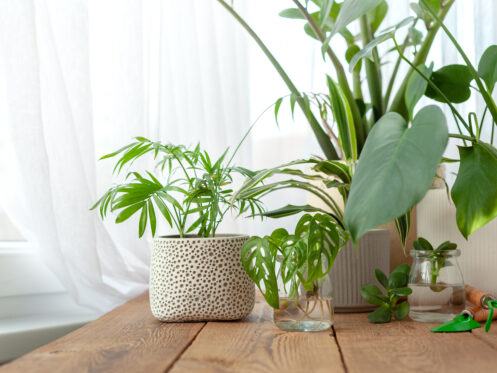Are you looking for an eco-friendly way to improve your home’s indoor air quality? If so, make sure to consider the many indoor plants that have strong reputations for cleaning indoor air.
1. Spider Plant
Spider plants, or Chlorophytum comosum, are well-known for their ability to filter the air, which has several positive effects on interior settings. They are quite good at removing typical contaminants such as carbon monoxide, formaldehyde, and benzene. Spider plants enhance the oxygen levels in a room by converting carbon dioxide into oxygen via photosynthesis. Furthermore, via transpiration, they contribute to humidity regulation. A more pleasant and breathable interior climate is a result of this natural moisture management.
2. Snake Plant
One of the most notable and beneficial things about snake plants (Sansevieria trifasciata) is the way they improve the air quality inside a building. They are very good at eliminating nitrogen oxide, formaldehyde, and benzene. Their nighttime operations improve air quality by converting carbon dioxide into oxygen. Snake plants are hardy, need little attention, and can survive in dim light. In addition, they help manage humidity for a more pleasant atmosphere by effectively releasing moisture.
3. Peace Lily
Peace lilies (Spathiphyllum spp.) remove indoor contaminants like formaldehyde, benzene, and ammonia. During transpiration, they release water vapor, which increases humidity and creates a natural moisture balance. Another remarkable quality of peace lilies is their capacity to trap mold spores in the air. This hardy plant requires little light and even less upkeep. Peace lilies not only bring beauty to any room, but they also purify the air by releasing oxygen.
4. Aloe Vera
The versatile plant known as aloe vera (Aloe barbadensis miller) has several uses, one of which is improving air quality. Its calming gel is well-known for its ability to eliminate benzene and formaldehyde from the air. During the night, this succulent produces oxygen, which increases the air’s freshness. Its thick leaves not only filter the air but also absorb water and release it back into the air, which helps regulate humidity. This low-care plant looks great in interior settings since it prefers indirect light.
5. Rubber Plant
Because of their powerful air-purifying properties, rubber plants (Ficus elastica) greatly improve air quality. Their effectiveness in eliminating typical contaminants such as formaldehyde, benzene and trichloroethylene is remarkable. Rubber plants are great for a wide range of interior settings since they are sturdy and versatile. Their larger, glossy leaves, which increase transpiration rates, contribute to higher humidity levels. This is of the utmost advantage in homes with dry indoor air. Furthermore, rubber plants improve air quality via photosynthesis by turning carbon dioxide into oxygen.
6. Boston Fern
A distinctive characteristic of Boston Fern (Nephrolepis exaltata) is its ability to improve air quality. This natural air purifier is well-known for its capacity to eliminate xylene and formaldehyde, among other contaminants. As a result of transpiration, the thick, feathery fronds increase humidity, making this plant a useful natural humidifier. In a symbiotic connection with interior surroundings, Boston Ferns flourish in indirect light but need continuous wetness. They require watering every few days, which means you’ll have to tend to them several days a week.
7. Dracaena
Because of their ability to filter the air, dracaena plants — which include a wide range of species — are great for improving the air quality in enclosed spaces. Their presence helps maintain a cleaner interior atmosphere by filtering out contaminants such as formaldehyde, benzene, and trichloroethylene. Their adaptability and resilience allow them to flourish in a wide range of light situations, making them a versatile choice for a variety of environments. During photosynthesis, dracaenas also emit oxygen, which helps to keep the air fresh.
8. Chinese Evergreen
The Chinese evergreen has a stellar reputation for removing harmful air pollutants such as formaldehyde and benzene. It is a great choice for many indoor situations due to its resilience and capacity to thrive in low light. Photosynthesis, which it employs to convert carbon dioxide into oxygen, leads to cleaner air. The beautiful variegated leaves of a Chinese evergreen not only enhance the air we breathe but also provide visual appeal to spaces.
9. Pothos or Devil’s Ivy
Pothos, also known as Devil’s Ivy, has exceptional air-purifying capabilities. Its trailing vines provide a larger surface area to purify the air. The oxygen released during its photosynthesis process freshens the air. It is an attractive, multipurpose plant that improves indoor air quality and adds a dash of elegance and verdant foliage to any room.
10. Parlor Palm
The Parlor Palm, scientifically known as Chamaedorea elegans, is a houseplant that greatly improves air quality by filtering out pollutants. This little palm tree helps create a more pleasant interior climate by absorbing harmful chemicals like benzene and formaldehyde. It is another type of indoor plant that tolerates a wide range of interior lighting situations and thrives in dim settings. During its transpiration process, the Parlor Palm increases relative humidity and acts as a natural dehumidifier. In addition, it helps keep the air cleaner by converting carbon dioxide into oxygen via photosynthesis.
11. Bamboo Palm
The Bamboo Palm (Chamaedorea seifrizii) is an excellent houseplant option for those concerned about indoor air pollution. One of its most notable qualities is the amount of air pollutants it can remove, including benzene and formaldehyde. This adaptable palm thrives in light to partial shade and is a great fit for many indoor spaces. The transpiration mechanism allows the bamboo palm to release water vapor, which aids in maintaining appropriate humidity levels. Photosynthesis, in which it participates, converts carbon dioxide into oxygen, significantly improves air quality.
12. English Lavender
When cultivated inside, the aromatic plant known as English lavender (Lavandula angustifolia) has a modest odor-reducing effect. Although lavender isn’t as effective as other plants at cleaning the air, its lovely aroma can help people relax and unwind. Because of its antimicrobial characteristics, lavender can also help keep indoor air cleaner.
13. Anthurium
Anthurium, with its showy blooms and shiny foliage, helps filter the air inside a home, making it a healthier place to live. Filtering out common contaminants like xylene, ammonia, and formaldehyde is a breeze with this tropical plant. Anthurium fits very well with a variety of interior environments since it thrives in diffused light. By releasing water vapor via transpiration, it helps maintain a suitable relative humidity. Anthurium also takes part in photosynthesis, which helps keep the air cleaner by turning carbon dioxide into oxygen.
14. ZZ Plant
The ZZ plant, scientifically known as Zamioculcas zamiifolia, is an easy-care houseplant that greatly improves air quality. Its ability to remove airborne contaminants, including formaldehyde, benzene, and xylene, has earned it widespread renown. It can go for long periods of time without watering because its succulent leaves retain water.
We Care Plumbing, Heating and Air offers a variety of plumbing, drain cleaning, cooling, heating and air quality services to make your home more comfortable. To learn more about improving indoor air quality in Murrieta, CA, give us a call today.







